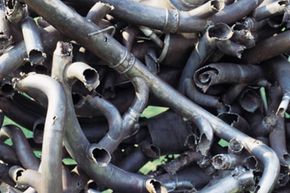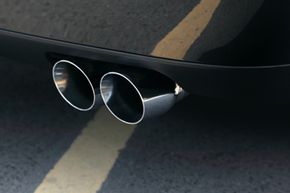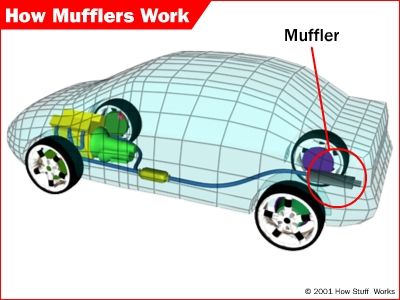If an engine ran perfectly, it would combust all its available fuel as it ran through its cycles, converting all the dirty bits to a source of power. However, leftovers exist as pollutants because an engine simply cannot be engineered to run perfectly -- there are far too many variables. Some amount of fuel will always remain unburned or partially burned, and these remnants must be quickly processed out of the vehicle, in the form of exhaust, to make room for the next cycle of engine combustion.
As we mentioned earlier, the exhaust first exits the engine and enters the system through the exhaust manifold. From there, it travels down the system through interconnected pipes until it exits through the tailpipe, near the back bumper. The pipes themselves actually help cool the exhaust, but they're mostly a way for the exhaust to travel to (and through) the catalytic converter and muffler.
The cat has to be as close to the engine as possible, because it isn't fully functional until it rises to operating temperature. In many cases, the manufacturer places the cat shortly after the manifold, so heat from the engine helps warm the cat and quickly bring it up to temp.
After the gases pass through the cat, which will burn off and remove up to 90 percent of the exhaust's toxins, the next priority is to filter the engine sound [source: Allen]. The muffler and resonator are usually situated right beyond the cat. There are many variations on this combination -- some will soothe the exhaust as much as possible, while others are specifically tuned for aggressive tones. From there, the exhaust moves through the remainder of the pipes until it exits the car.
With all those chemicals swirling around, it's quite a feat that the exhaust system actually works as well as it does. A well-maintained exhaust system should last two to three years, but the pipes incur damage both inside and out. On the outside, they're susceptible to road conditions, such as impact from debris and environmental factors, such as snow, ice and road salt.
However, a more substantial cause of exhaust system degradation is internal, and it can't be seen until the pipes have corroded through with rust. We know that as the engine combusts fuel to make power, byproducts of this process are left over -- that's why the exhaust system is needed. One of these byproducts is acidic moisture, and it's really damaging to metal. Unfortunately, there's really no way to keep the insides of the pipes clean.
When an exhaust pipe rots through or a connection comes loose, an exhaust leak occurs. A leak is almost always immediately apparent with a loud, obnoxious sound and, possibly, drivability issues like an intermittent fluctuation in power. But, believe it or not, these aren't the real problems. It gets a little more serious if the leak occurs before the catalytic converter, which means the exhaust isn't being properly processed and all those hot chemicals are spilling everywhere into the atmosphere. It's always a good idea to get leaks fixed as soon as possible to avoid subjecting yourself, your passengers and your surroundings to unfiltered exhaust fumes.





